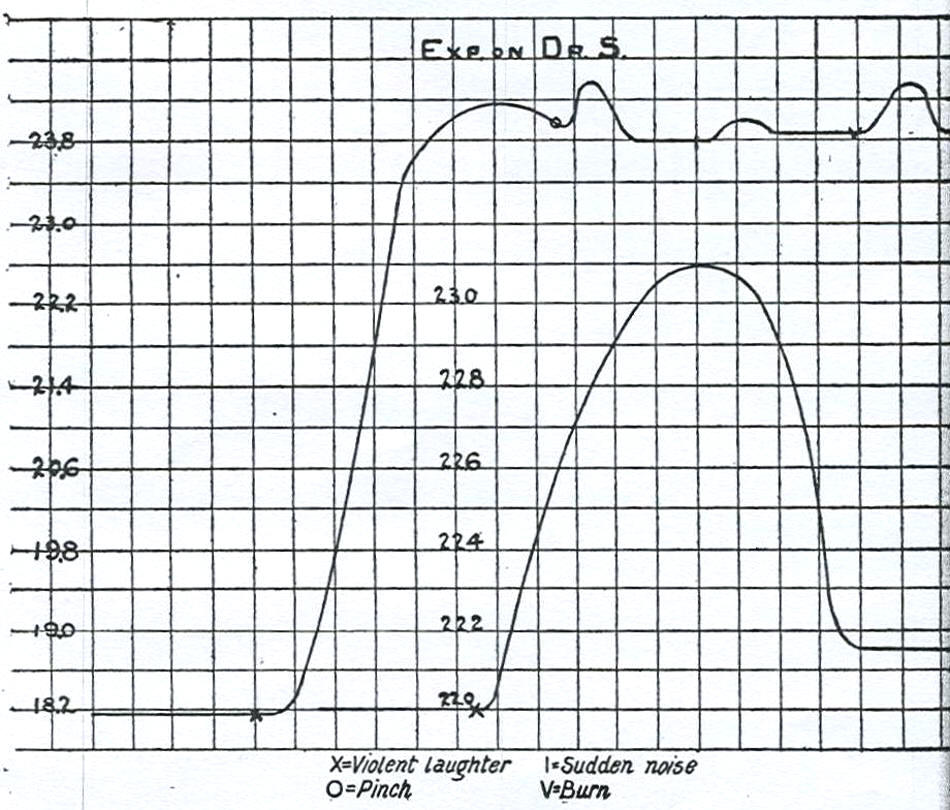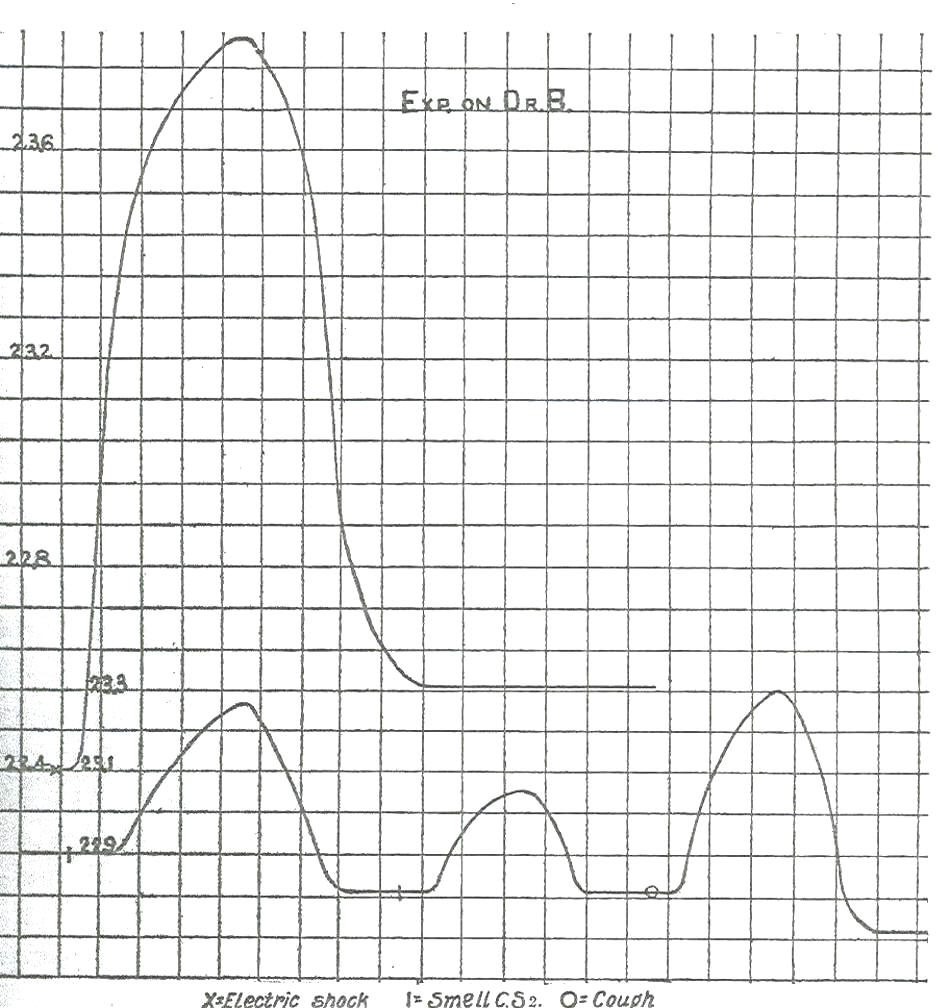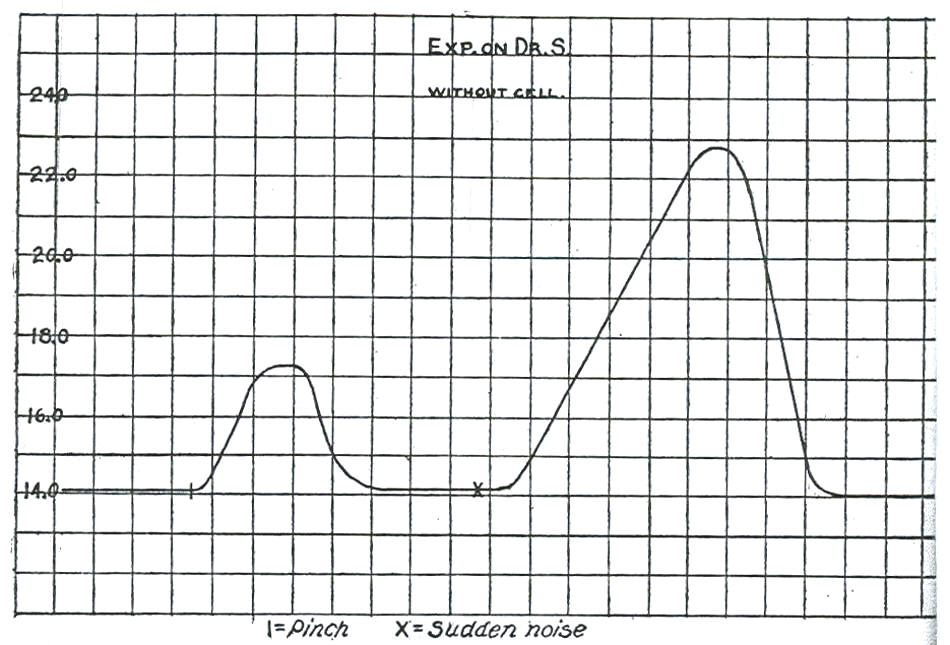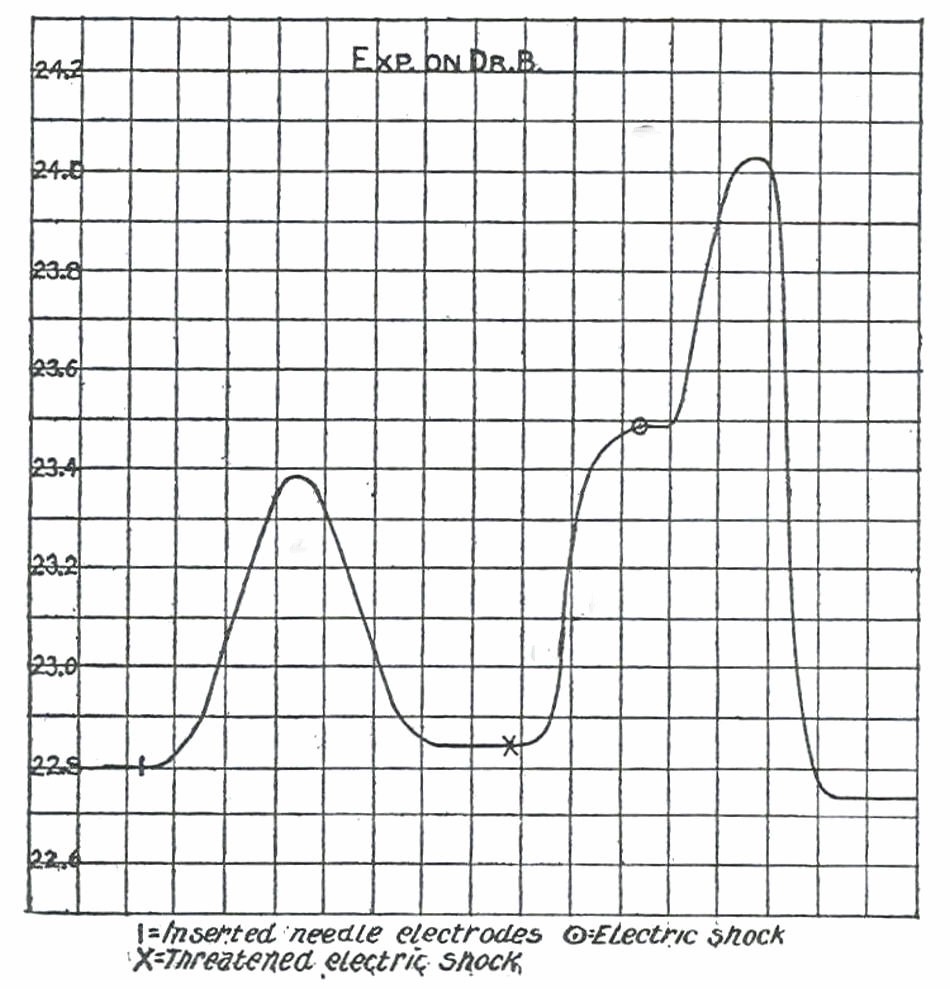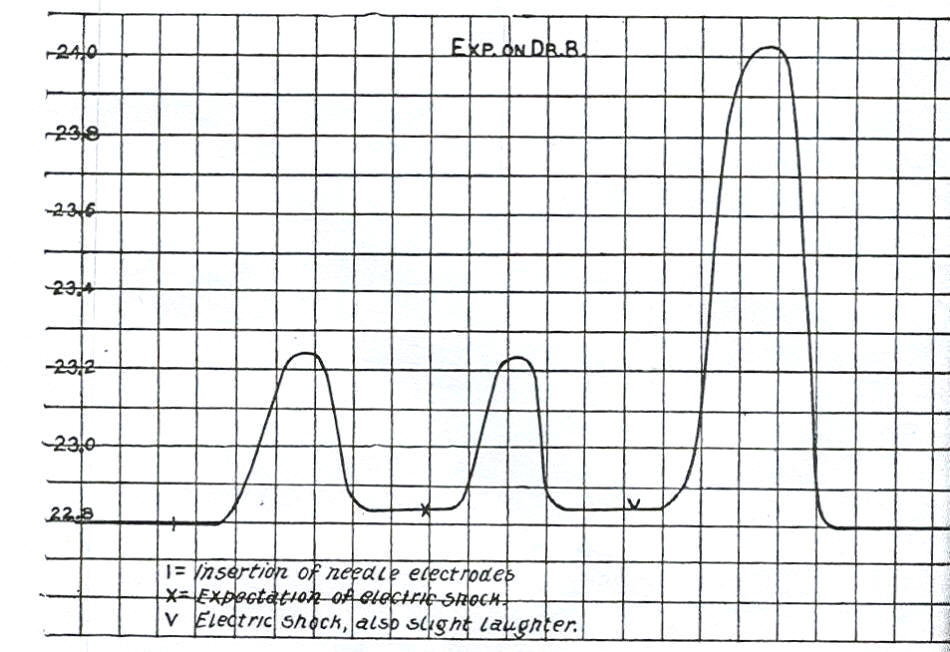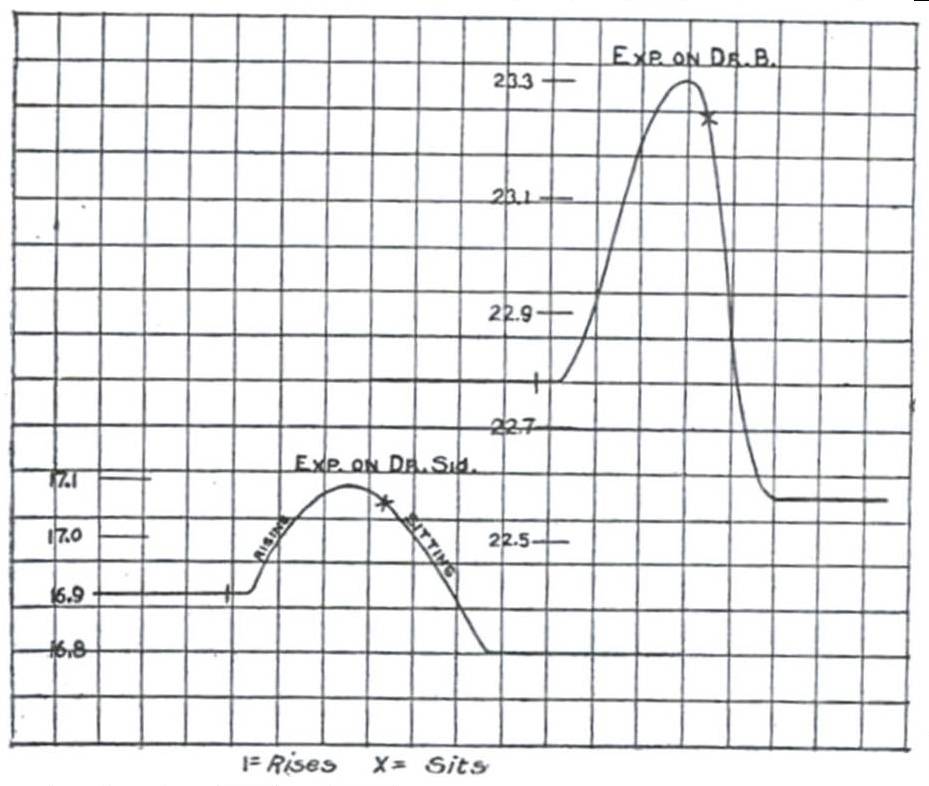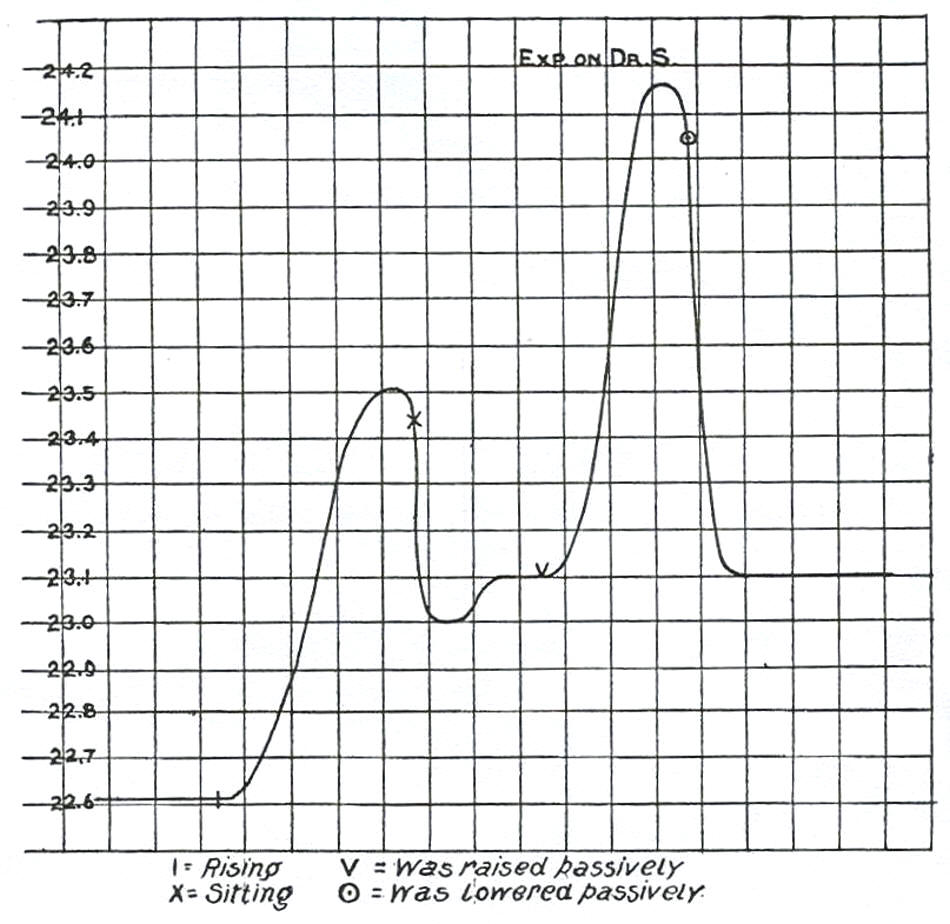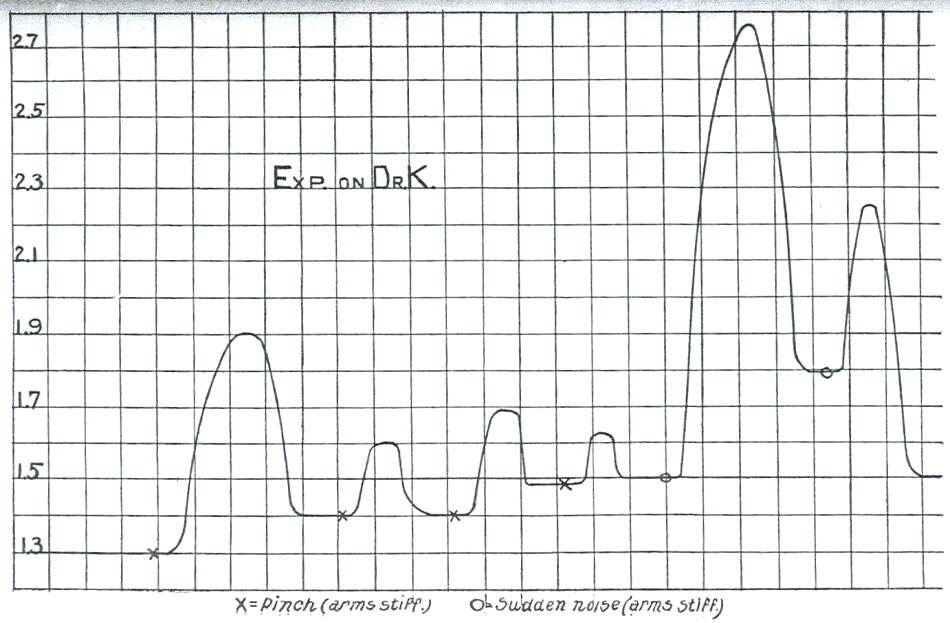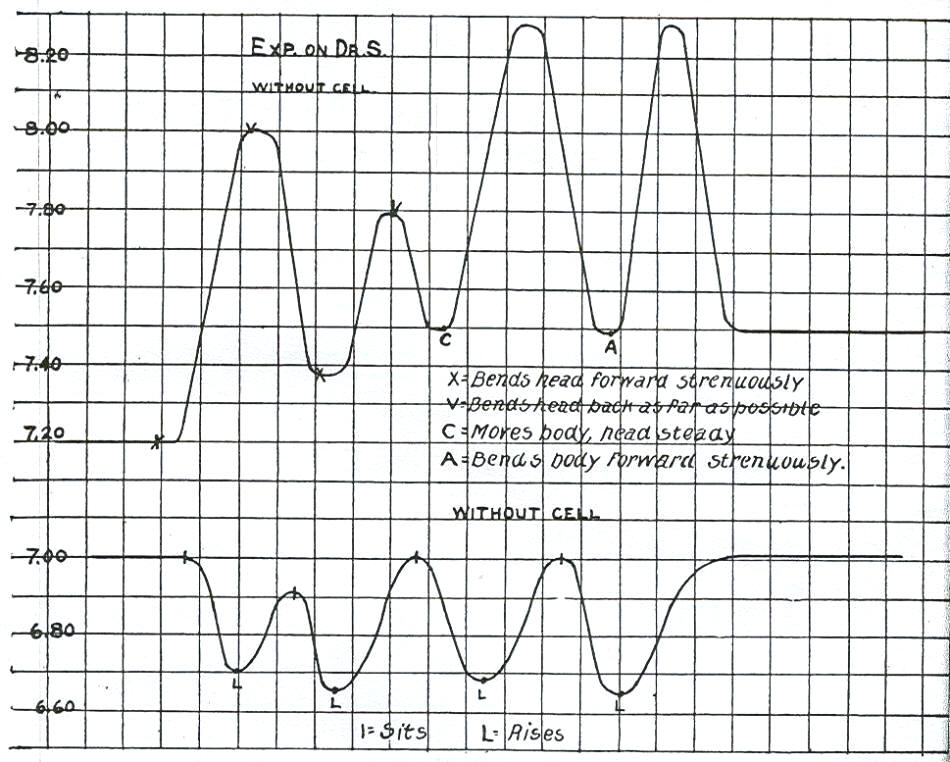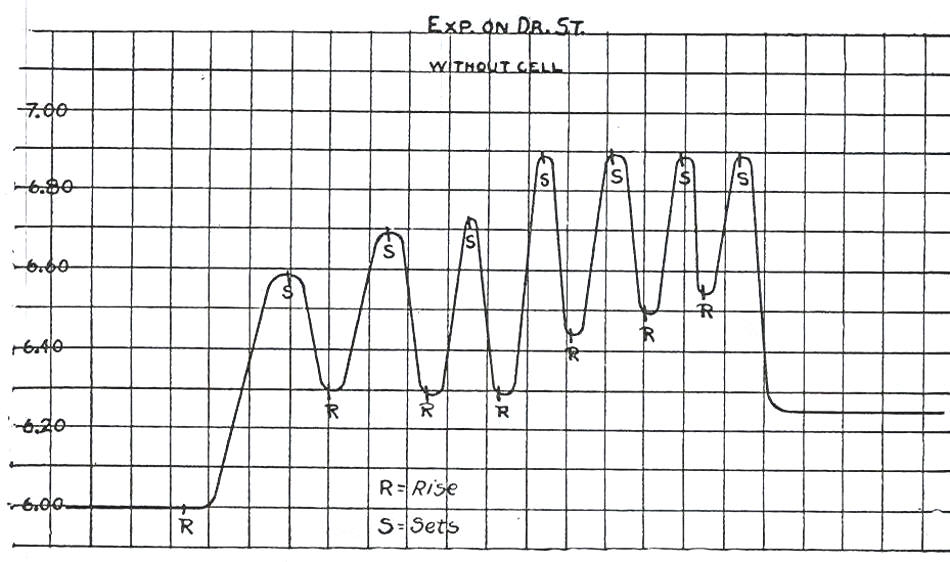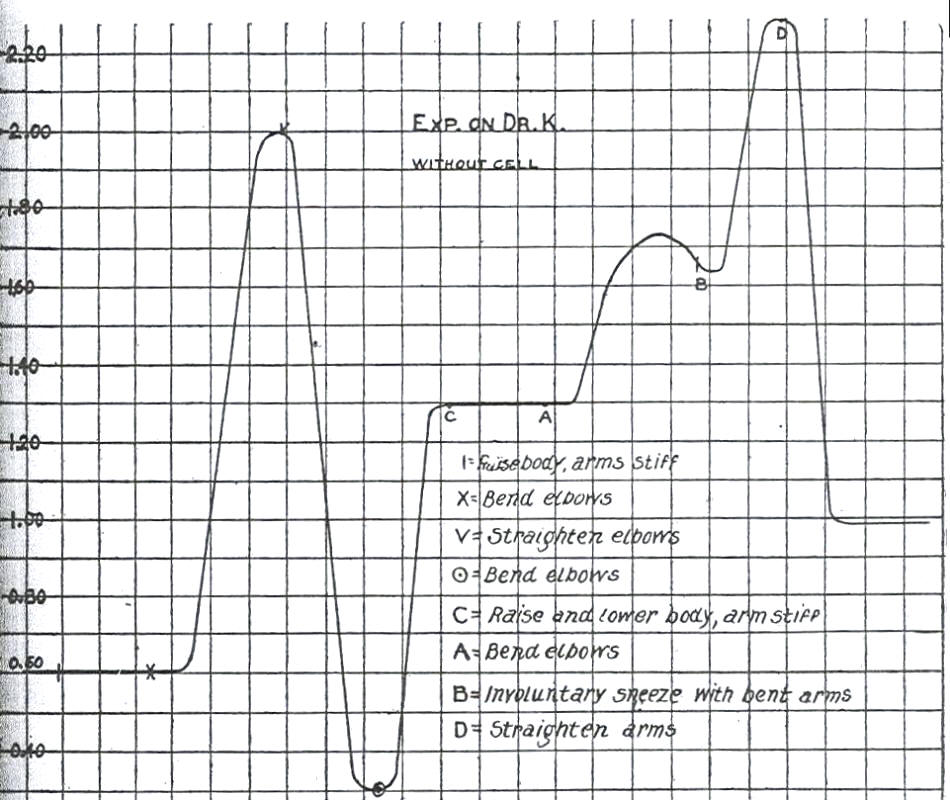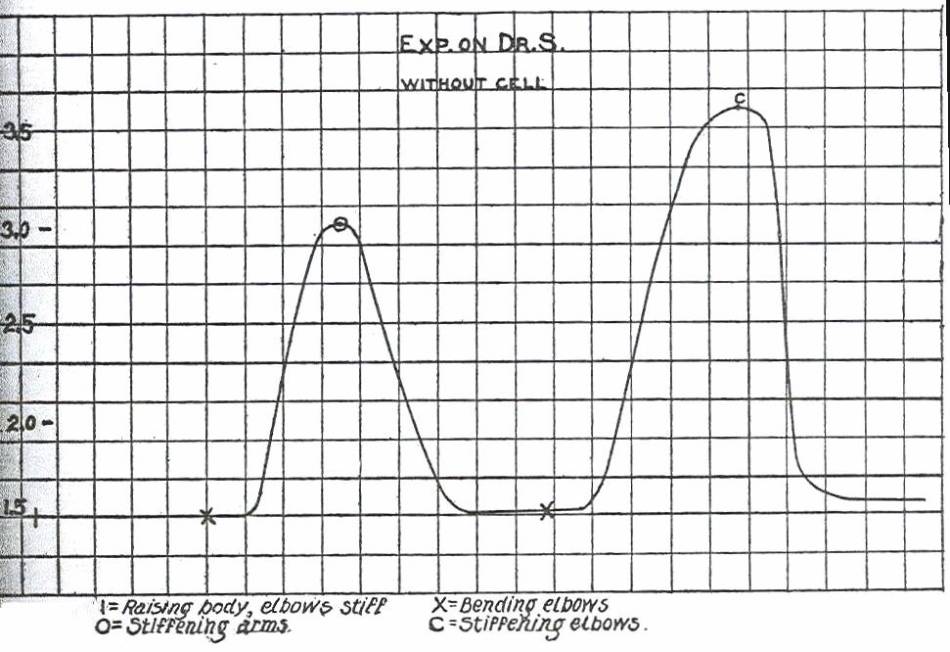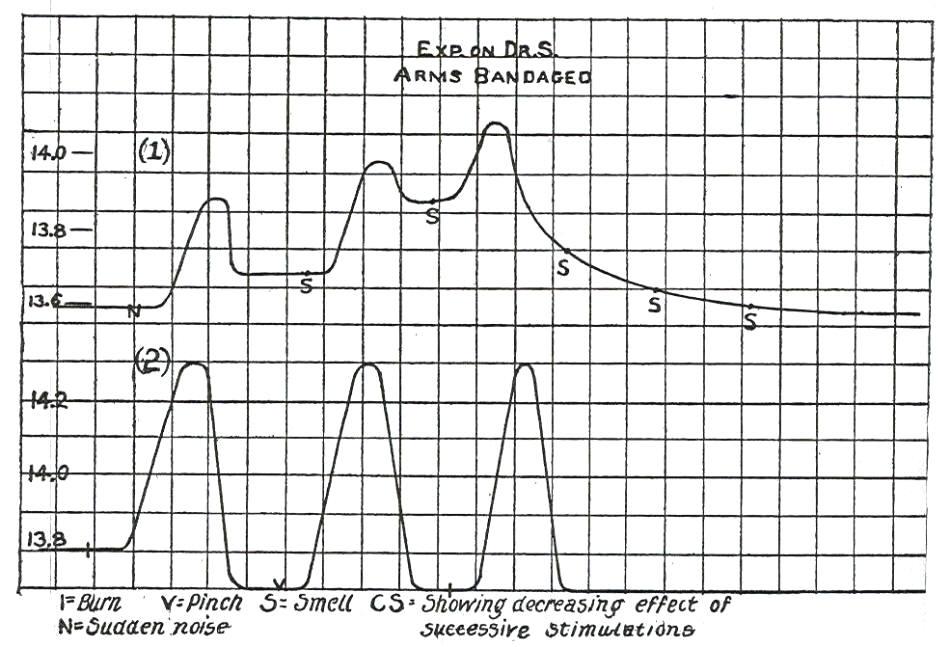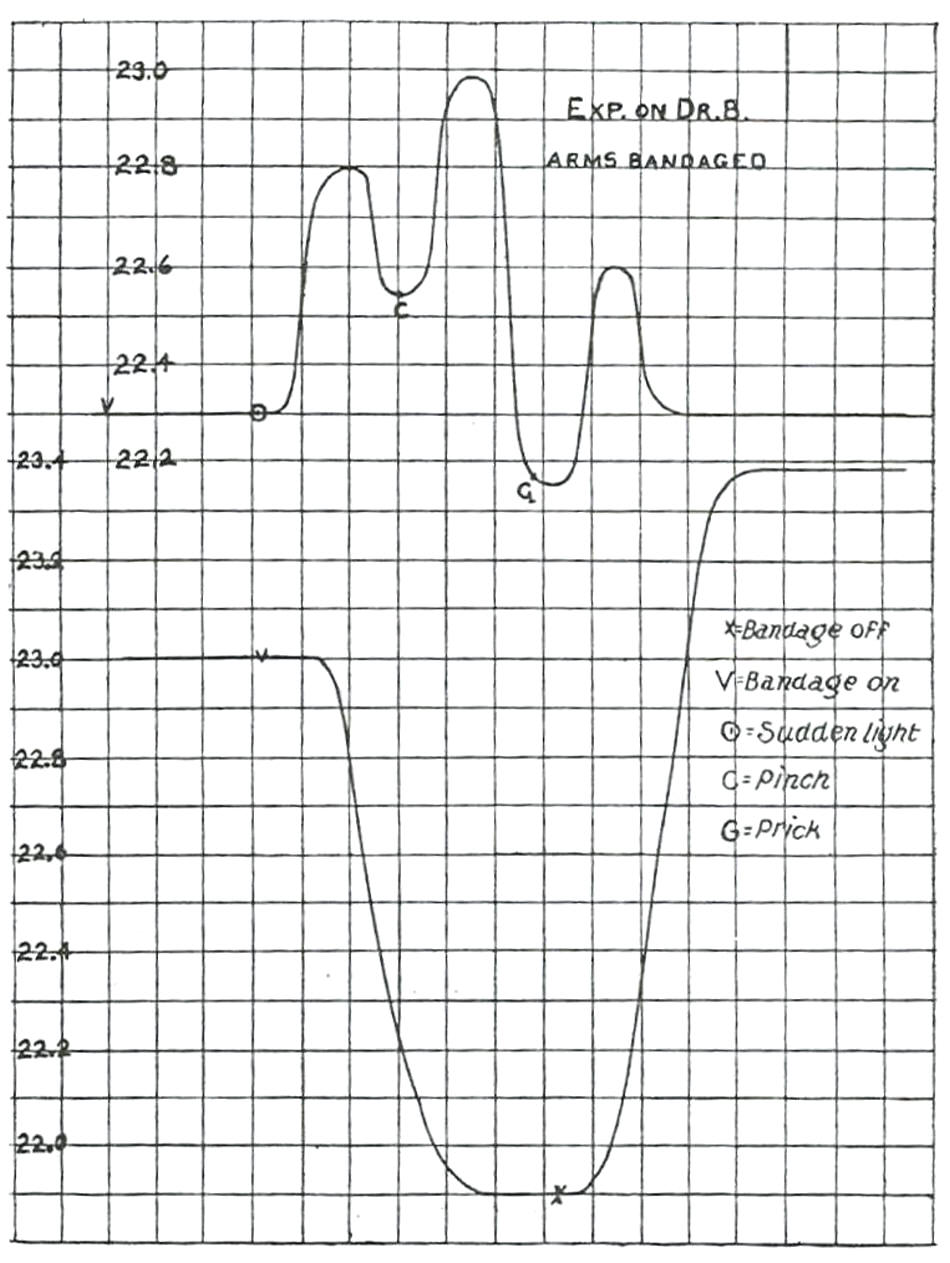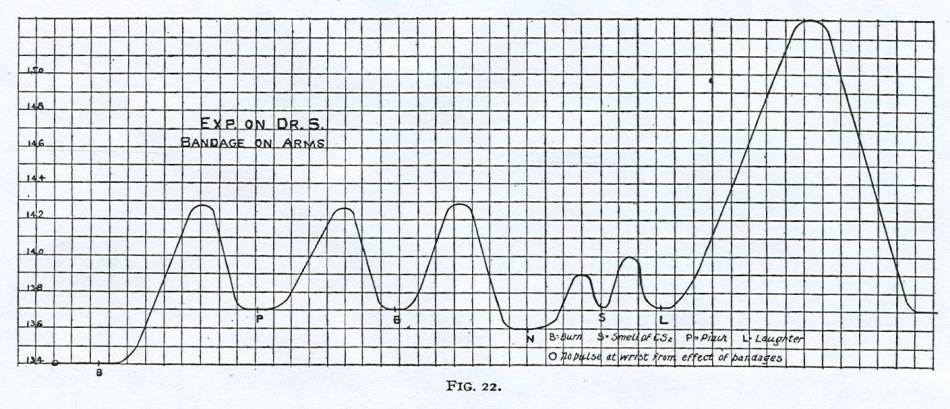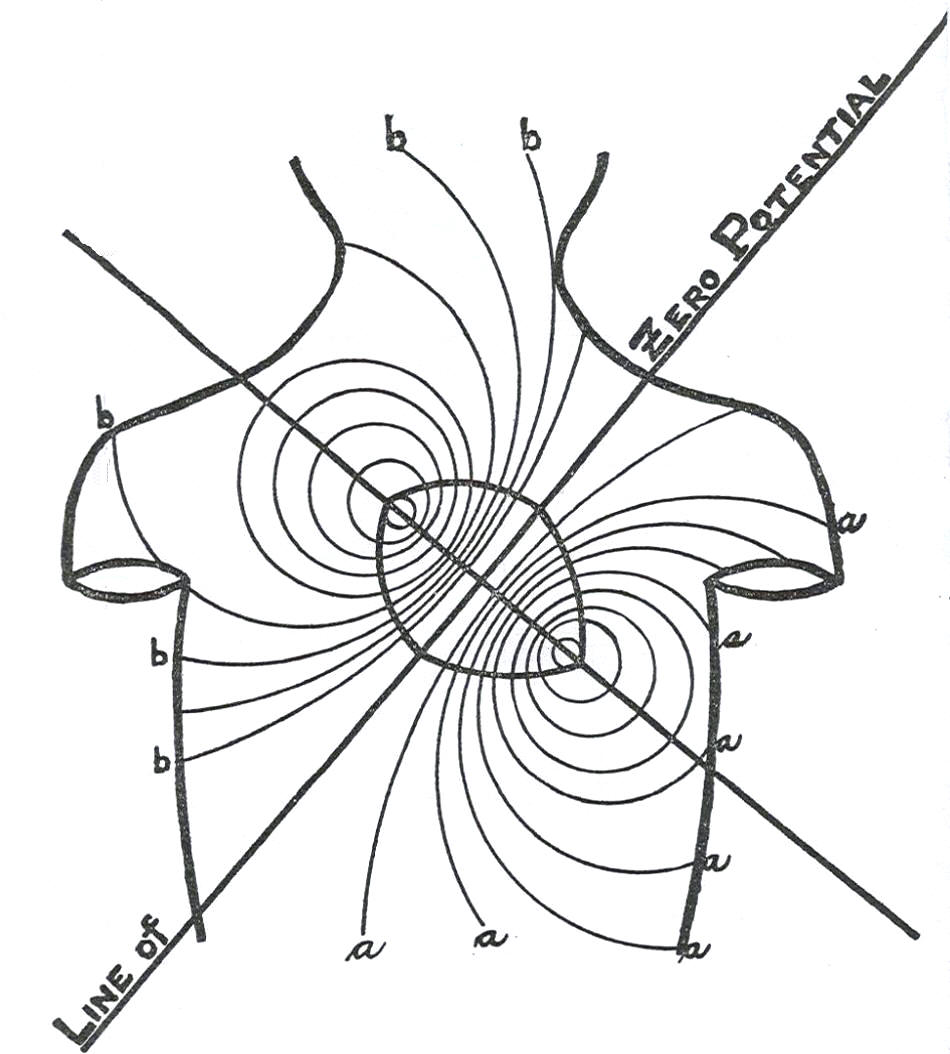|
Home Boris Menu Galvanic Research Menu Laboratory Instruments Used Part I
I The galvanometric variations during emotional states may be taken to indicate that the physiological processes accompanying emotions change the resistance of the circuit by changing the resistance of the body. This resistance factor is the one to which these variations are commonly referred by previous investigators. Further experimentation, however, points in a different direction.
It seemed highly probable that not an inconsiderable fraction of the total resistance of the body measured by the immersion of the hands in our liquid electrodes was due to the skin layer. Variations in the skin area in contact with the electrodes were eliminated by the use of liquid electrodes instead of metal electrodes used by other investigators. The shellac and paraffin with which we covered the subject's wrists as well as the splints put on the hands made the skin area washed by the liquid electrodes constant, so much so that violent stirring of the liquid with the hands did not change the reading of the galvanometer. The galvanometric variations observed under conditions of stimulation could not therefore be referred to variations in skin contact. If resistance be the factor, then the galvanometric variations observed may either be due to changes of resistance of the constant area of the skin or of the body through which the current passes. That the galvanometric deflections are due to variations in resistance of the skin is a view commonly held by many investigators.
Skin resistance can, however, be eliminated by the following procedure: Hypodermic needles were inserted well under the skin until blood flowed freely. The hands with the needle in position were placed within the liquid electrodes. The change in deflection was slight, about 2 millimeters in a total deflection of 20 centimeters, or about 1 per cent. After a few minutes the reading was the same as before the insertion of the needle electrodes. The deflection was probably due to the stimulation caused by inserting the needles. That is, after a few minutes the deflections with the needle electrodes did not differ from those without the needle electrodes. Skin resistance was even more conclusively eliminated by a series of experiments which will be described in their appropriate place. With the needles inserted curves identical in form with the preceding ones were obtained. Following are two curves typical of a number obtained under these conditions.
In considering the resistance of the body we may possibly regard the temperature of the body as a factor concerned in the observed galvanometric deflections. Electrolytes have a positive temperature coefficient of about 2 per cent per degree. It was thought that contractions of the muscles, voluntary and involuntary, as well as other catabolic processes that may go on in the body during an emotional state may possibly develop heat and thus account for the change in the deflections. Granted that sufficient heat is developed by muscular and chemical activities involved in the catabolic physiological processes concomitant with emotional states we may well account for the galvanometric variations. The factor of temperature had all the more to be taken into consideration as the experiments performed seemed to point in that direction. That is, bending of the arm, strenuous bending of the head, rising, sitting, coughing, laughing, whether spontaneous or artificial, any violent muscular strain or exercise especially of the arms gave rise to appreciable variations. Thus in some cases violent laughter, though artificial in character, caused a galvanometric deflection of 6-8 centimeters. Under other more favorable conditions described further the deflection amounted to more than 50 centimeters. We may also call attention to the experiments in which we artificially varied the temperature of the arms. Heating and cooling the arms put in an Esmarch bandage so as to exclude circulatory variations brought about galvanometric deflections.
The experiments with hot and cold applications gave but slight variations insufficient to account for the galvanometric phenomena observed under the influence of emotional states. The variations due to raising the temperature did not differ' from those due to lowering the temperature. Furthermore, after a minute or two of continuous cooling or heating the arms the reading was the same as that before the temperature change. The hot and cold applications acted therefore in the nature of mere temperature stimulations. The galvanometric variations observed upon rising and sitting were just as marked when the subject was raised passively and lowered passively as when he raised himself actively so that there was no question of exercise. Rising and sitting, changes in the position of the arms, was responsible for variations. The curves, Figs. 13-19, show the effect clearly.
From these experiments it seems that muscular activity of those parts of the body actual1y forming the circuit bring about galvanometric deflections, while activity of the more remote parts of the body are ineffective.
II It was supposed that the galvanometric deflections might be due to variations of the circulation under the influence of emotions. The circulation was cut off by Esmarch bandages. A galvanometric deflection was observed on putting on the Esmarch bandages and also on taking them off, as it was in the case of any other intense stimulus. What, however, completely eliminates circulation as the determining factor is the significant fact that when the Esmarch bandages were on, galvanometric deflections were obtained under conditions of sensory stimulation and arousal of emotional states. The Esmarch bandages were kept on the subject as long as he could stand them. The circulation was effectually cut off, the pulse was gone and the hand assumed a cadaverous hue; still the same galvanometric deflections were easily obtained under the same mental and purely physiological conditions, such as emotions, sudden sensory stimulations, rising, sitting, coughing, laughing and muscular activity, especially of the arms. The following curves may be regarded as typical of the rest.
These experiments prove conclusively circulation has nothing to do with the galvanic investigation. Our experiments go to prove that the causation of the galvanometric phenomena cannot be referred to skin resistance, nor can it be referred to variations in temperature, nor to circulatory changes with possible changes in the concentration of the body-fluids. Since the electrical resistance of a given body depends on two factors―temperature and concentration―the elimination of both factors in the present case excludes bodyresistance as the cause of the deflections. Our experiments therefore prove unmistakably that the galvanic phenomena due to mental and physiological processes cannot be referred to variations in resistance, whether of skin or body. Resistance being excluded the galvanometric deflections can only be due to variations in electromotive force of the body.
III In our experiments on the electromotive force we were partly guided by Dr. Waller's work on the electromotive changes connected with the beat of the mammalian heart.l The heart-beat should be taken into consideration as one of the possible causes of galvanometric deflections due to various psycho-physiological and purely psychological processes. Experimenting with the capillary electrometer Waller came to the conclusion that "a marked electrical variation is manifested at each pulsation of the heart." This electrical variation was manifested by 'leading off' from the surface of the body. Thus with each beat of the heart an electromotive force is set up causing a non-symmetrical distribution of potential over the body. To quote Waller: "The contraction of the ventricles is not simultaneous throughout the mass, but traverses it as a wave. Inequalities of potential at different parts of the mass are consequently established at the beginning and at the end of each systole. Or to reverse the order of statement, the inequalities in question are proof of the passage of a wave of excitation. The distribution of these inequalities of potential is represented diagrammatically in Fig. 23.
“These data being transferred to the entire body as in Fig. 23 we have the portion a, a, a . . . as the area in which the potential of A is distributed, and the portion b, b, b . . . as the area in which the potential of B is distributed. "Electrical variations will be manifested when any two points and a and b are led off; no electrical variations will occur when any two points a and a, or b and b, on the same equipotential line, are led off; small electrical variations will be obtained when two points a and a, or b and b on different equipotential lines are led off." Working with the capillary electrometer Waller found that certain combinations were favorable, while others were unfavorable to manifestations of marked electrical variations due to cardiac beat. The favorable combinations were the following:
The unfavorable combinations were:
Right foot and left foot. Mouth and right hand. In short, according to Waller, electrical variations are observed when two dissimilar points are connected with the electrometer, while electrical variations are absent or faint when two similar points are connected, similar and dissimilar points being defined according to Fig. 23. We repeated Waller's experiments, but we could not confirm his results. Our experiments do not confirm his favorable or unfavorable combinations. Further work is in progress in this connection. What we did find was that a reversal of position of the hands―putting the right in place of the left hand―made a difference in the magnitude of the deflection and occasionally in its direction. To define positive and negative deflections for our experiments, a cell was introduced into the circuit and the direction of the deflection was called positive. The terminal of the galvanometer to which the positive pole of the cell was connected was consequently defined as positive. In the following record of data, therefore, l. h. (+) means that the left hand was connected to the positive terminal of the galvanometer thus defined. The following tables give the results of our experiments:
TABLE VI EXPERIMENTS ON DR. S. First Series
Repeated 5 times; same results.
TABLE VII EXPERIMENTS ON DR. S. Second Series
TABLE VIII EXPERIMENTS ON MR. R.
(2) is a repetition of experiment (1).
TABLE IX EXPERIMENTS ON DR. B.
TABLE X EXPERIMENTS ON DR. K.
TABLE XI EXPERIMENTS ON MR. COL. First Series
TABLE XII EXPERIMENTS ON MR. COL. Second Series
TABLE XIII EXPERIMENTS ON DR. ST.
From these tables it is clear that the absolute magnitude of the deflection varies according to the varying conditions of the experiment. Different experiments performed with different concentration of electrode solutions gave different deflections, in fact the direction and magnitude was varied at will in this way. Also substituting lead electrodes for copper electrodes changed the deflections largely, and different parts of the skin gave different original deflections. However, superimposed upon this original steady deflection is a deflection due to the various stimulations given.
IV A further study offers direct evidence that the deflections due to stimuli are caused by electromotive forces. Following are the experimental results:
TABLE XIV. EXPERIMENTS ON DR. K.
TABLE XV EXPERIMENTS ON DR. S.
TABLE XVI EXPERIMENTS ON DR. ST.
TABLE XVII EXPERIMENTS ON MRS. S.
TABLE XVIII EXPERIMENTS ON DR. ST.
Stimulus repeated gave no further deflections.
An examination of Tables XVI and XVIII shows that the effect of the stimulus is sometimes to increase the current and sometimes to decrease the current. This cannot be due to change of resistance of the body, but must be due to an electromotive force. Table XVIII shows that both increasing and decreasing the temperature caused the absolute deflections to diminish when the 1.h. was (+) and to increase when the 1.h. was (−). That is, the change of temperature acted simply as a sensory stimulus causing in every instance an E.M.F. in the same direction relatively to the body, whether the change be an increase or a diminution of temperature. With the 1.h. (+) the E.M.F. due to the stimulation was in the opposite direction to E.M.F. already existing in the circuit and consequently diminished the existing deflection, while with the hands reversed (i.e., l.h. (−)) the E.M.F. due to the stimulation was set up in the same direction as before within the body, which now, since the body has been reversed, is in the same direction as the E.M.F. existing in the circuit. Hence upon reversal the existing deflection was increased. From all these data it is evident that a stimulus causes a definite deflection superimposed upon the original deflection which is not always in the same direction. Had these superimposed deflections been due to resistance-changes under stimulation then reversing the hands would not have changed the direction of this deflection. But the above data show that in many cases the direction of the superimposed deflection is reversed with reversal of hands. This effect then having definite direction must be of the nature of an electromotive force. Is the electromotive force produced by stimuli, by emotional states and by various other physiological processes due to variations of secretion-currents in the skin? That the skin has little or nothing to do with the phenomena under investigation can be proven by a series of experiments in which the skin is totally excluded. The skin was covered with shellac and paraffin leaving only the finger nails exposed. Under such conditions definite galvanometric deflections were obtained, deflections induced by emotional states and physiological activities. The following tables obtained with no cell in the circuit are characteristic:
TABLE XIX EXPERIMENTS ON DR. ST. Metal Electrodes―Finger Nails Only
TABLE XX EXPERIMENTS ON DR. K. Metal Electrodes―Finger Nails Only
TABLE XXI EXPERIMENTS ON DR. S. Metal Electrodes―Finger Nails Only
Similar experiments were performed with tinfoil over finger nails to improve contact:
METAL ELECTRODES
NACL ELECTRODES
This experiment was repeated several times with same results.
In these experiments evidently all skin effects were excluded. Deflections under the influence of sensory stimulations were observed which, as in our earlier experiments, show definite directions and which are consequently referable to electromotive forces in the body. Our experiments thus clearly point to the fact that active physiological, sensory and emotional processes, with the exception of pure ideational ones, initiated in a living organism bring about electromotive forces with consequent galvanometric deflections. We take great pleasure in thanking Dr. W. Bemis, Dr. A. Stevenson and especially Dr. D. F. Comstock for the valuable assistance they have given us in performing these experiments. The experimental part of this research was carried out at the Research Laboratory of Physical Chemistry of the Massachusetts Institute of Technology and at Dr. Sidis' psychopathological laboratory.
_________ 2 l. h. stands for left hand; r. h. stands for right hand.
Boris Menu Galvanic Menu Part I
|
